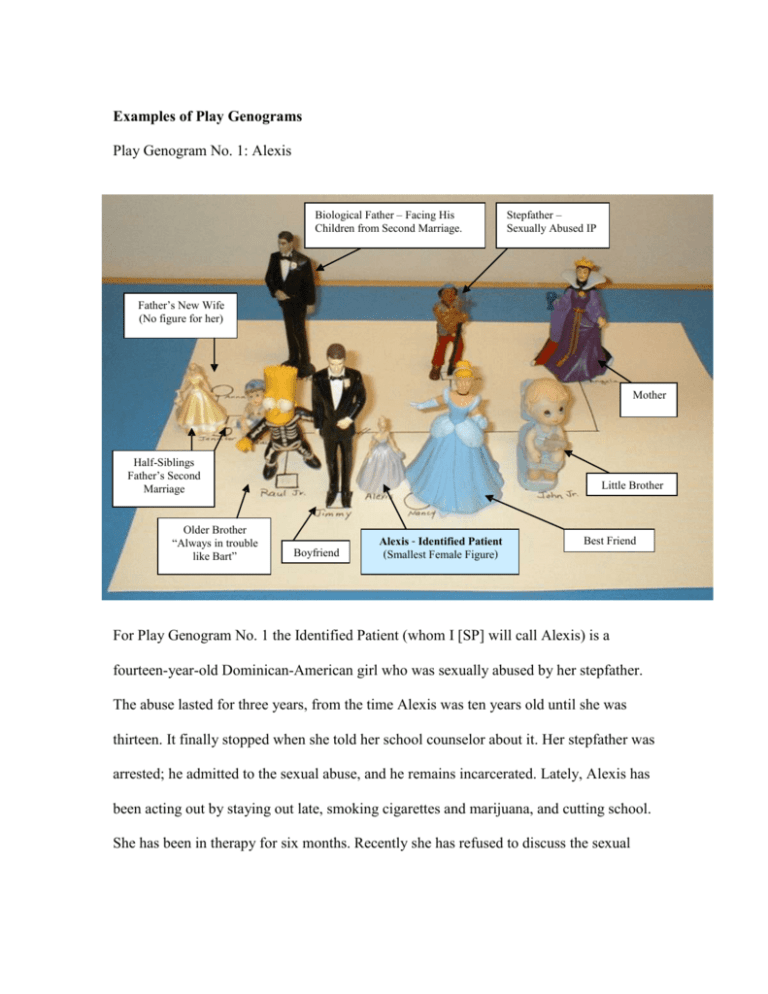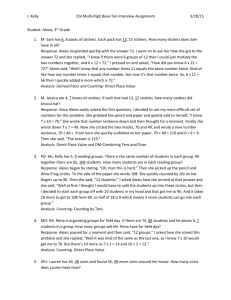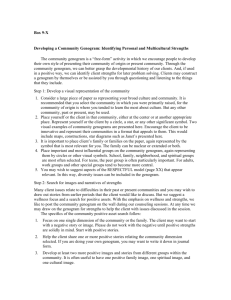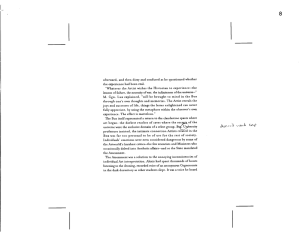Examples of Play Genograms
advertisement

Examples of Play Genograms Play Genogram No. 1: Alexis Biological Father – Facing His Children from Second Marriage. Stepfather – Sexually Abused IP Father’s New Wife (No figure for her) Mother Half-Siblings Father’s Second Marriage Older Brother “Always in trouble like Bart” Little Brother Boyfriend Alexis - Identified Patient (Smallest Female Figure) Best Friend For Play Genogram No. 1 the Identified Patient (whom I [SP] will call Alexis) is a fourteen-year-old Dominican-American girl who was sexually abused by her stepfather. The abuse lasted for three years, from the time Alexis was ten years old until she was thirteen. It finally stopped when she told her school counselor about it. Her stepfather was arrested; he admitted to the sexual abuse, and he remains incarcerated. Lately, Alexis has been acting out by staying out late, smoking cigarettes and marijuana, and cutting school. She has been in therapy for six months. Recently she has refused to discuss the sexual abuse in therapy, stating that she has already talked about the sexual abuse, it is in the past, and she does not have any feelings about it anymore. I drew the nuclear family genogram on a large sheet of paper and asked Alexis to add anyone she wished to include in her genogram. She decided to add her biological father’s new family, her best friend, and her boyfriend. I drew a marriage line for her father’s second marriage and his wife and their children, a girl and a boy. Then I drew a detached circle, below and to the right of Alexis’s name for her best friend, and a detached square below and to the left of her name for her boyfriend. Next I asked her to choose a miniature that best showed her thoughts and feelings about everyone in the family, including herself. Note that Alexis placed her biological father looking toward his two younger children from his second marriage and away from the rest of the family. Alexis chose the smallest female figure to represent herself, and she chose the “queen” to represent her mother. She chose an ominous figure with a weapon for her stepfather. These were all compelling visual representations of her feelings about herself and her parents. However, I did not voice any of my observations; I simply asked her to tell me about her genogram. She stated, “I chose this figure for my father because he has darker skin and he is very handsome.” Then she described all of the figures representing the children, stating why she chose each one. She said that she chose the pretty Cinderella figure for her best friend “because she is pretty,” and the “light-skinned guy” for her boyfriend because he is handsome and he has light skin. She pointed to the small girl and baby miniatures representing her half-siblings and talked about how much fun she had with them when she visited her father in the Dominican Republic a year ago. For her older brother Alexis chose the cartoon figure “Bart” because, as she described it, he is “always in trouble in high school, he can’t get away with anything.” Interestingly, her father’s second wife was the only person for whom she did not choose a miniature. She had not yet talked about the figures she chose for her mother or her stepfather. I pointed to the figures and asked, “Tell me about these.” This opened up the conversation and she said, “I chose this ugly guy for my stepfather because he looks mean and scary.” She went on to say how she hoped he would stay in jail and she worries that he may get out and come back to her house. She also talked about the figure for her mother, stating that her mother has complete power over her. In reply to this I said, “Tell me more about that.” (The goal of the therapeutic dialogue when using the play genogram is to ask open-ended questions, allowing for the patient to express her thoughts freely.) Alexis then expressed feelings of fear, anger, and powerlessness. She also talked about her biological father’s role, saying that if he had been there for her none of “this would have happened.” Note that the placement of her father’s miniature, looking toward his younger children from his second marriage and away from her own nuclear family, was a powerful visual representation of her feelings of abandonment. The play genogram opened up the possibility for Alexis to talk about her feelings regarding the sexual abuse. She was able to process her feelings again, even though she thought she had nothing more to say about it. She also discussed her ambivalence regarding her mother’s power in various ways. Her mother had been powerless when her stepfather was abusing her. Now her mother has power because she knows what happened and she has filed for divorce. Alexis said that she feels sometimes her mother has too much power over her because she sets limits. On the other hand, she stated that her mother is using her power for good because she wants the best for her children. I took a picture of the play genogram for the file. In future sessions I will use the picture to facilitate more discussions about Alexis’s feelings regarding the sexual abuse and how it has affected her and her family.









